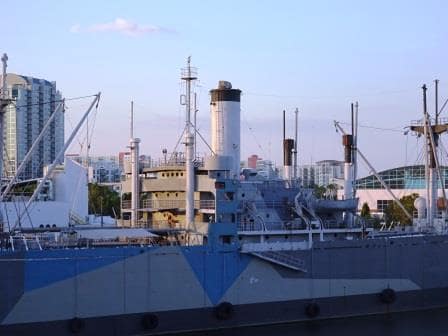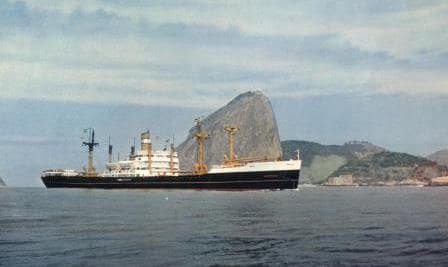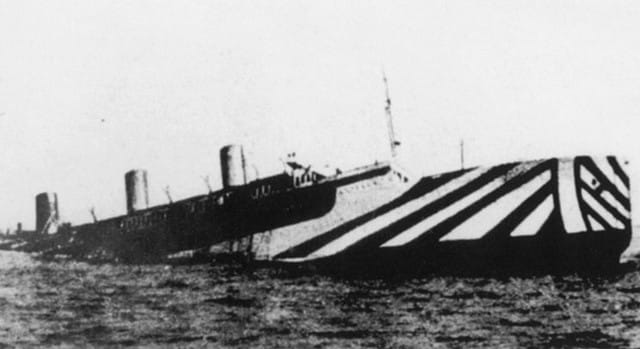Because we left Tampa exactly on time, we also managed to arrive in Key West exactly on time. As mentioned last cruise, the time /distance between Tampa and Key West is really tight and 30 minutes late from Tampa automatically means 30 minutes late in Key West. Luckily for the rest of the cruise we have some time up our sleeve in regards to the schedule. While going to Key West we sailed through the remnant of a weather front in the early morning but by the time we reached the pilot station it was sunshine galore, ensuring a very warm day, accompanied by a moderate breeze. Thus a regular Key West day, to enjoy for all the guests. The Oosterdam was the only ship in port today and we docked again at B pier, which means tonight we can sail only as soon as the sun has set over Mallory Square.

The bridge profile of the American Victory. If you look at the Aagtedyk below, you can see that their profiles were all the same.
I mentioned the cargo ship in Tampa which is now a museum. It showed up in the port in 1999 after a long career in and out of active service, which started in 1945. The American Victory is one of 534 cargo ships of the same basic design ( but with a lot of variations for special purposes) built during the second world war to satisfy the need of the Allied forces to transport troops and equipment. It was a follow up design of the Liberty class ships of which over 2700 were built. However their average speed was about 10 knots and the operating authorities wanted something faster and thus the Victory Class was designed which could manage about 16 – 17 knots.
After the war all these ships became surplus to requirements, no longer needed, and some went in layup and some were sold to commercial operators. Many of them went to Europe to replace the tonnage the shipping companies there had lost during the war. Holland America also bought a number of them. One Liberty (the ss Blijdendijk (II)) and in total 11 of the Victory class that were very well suited to maintain a regular liner service for the company. These were called the A class with the very Dutch names of:
Aalsdyk, Appingedyk, Amsteldyk, Arkeldyk, Averdyk, Arnedyk, Aardyk, Abbedyk, Axeldyk, Akkrumdyk, Arendsdyk

This is the ss Aagtedyk, ex Texercana Victory here seen sailing past Sugar Loaf mountain outside Rio de Janeiro.
There were all (nearly) the same although some of them had been fitted out in different ways, depending on what they would be used for in the war effort. When they were all put back to their basic cargo ship design some differences remained. I have in my collection a story about one of the captains who sailed on most of them, and who hated one ship (he did not mention which one) where the door from his bedroom was the other way around to the rest of the A class. That resulted for him in bashing his head each time he was called and wanted to run to the bridge, only to run into the door. Most of these ships sailed until the mid sixties when they could not keep up any longer with the more modern motor ships which were better suited to the changing trade conditions.
The American Victory came in service just before the war ended and sailed in the Pacific. Then she went into layup and was used again in 1951 – 1954 for the Korean War effort. Then from 1966 to 1969 she was involved in the Vietnam War and then went back into layup. Around this time most of her sisters started to go to the scrap heap. In between she sailed for a few commercial carriers such as American Export Lines where she was involved in carrying cargo to Europe under the Marshall Plan. Then in 1999 she showed up in Tampa and is now the center piece of the American Victory Mariners Memorial & Museum.
What fascinated me this time was that she had been given a different hull paint job, before she had been regular Navy grey but now she sported a “dazzle paint” camouflage pattern. The earliest form of dazzle paint was introduced in the First World War and invented by an English Gentleman called Wilkinson. The idea was that if you painted a ship in unusual patterns & colors then it would be hard for a submarine commander to see where the ship exactly was. Especially in boisterous seas and grim weather. It was used for most of the First World War especially for passenger liners who with their high profiles stood out like a sore thumb against the elements. If the scheme was successful is debatable. One of our ships under construction during the first world war, the Statendam II, was seized by the British and used as a troop ship. It had dazzle paint but it was still torpedoed.
The American Victory is one of three preserved cargo ships of the Victory Class; the other ones are the Lane Victory in Los Angeles and the Red Oak Victory in Richmond California. She still sails on occasion, often manned by old timers who did it for real in the days when these ships were still out and about.
We will sail tonight as soon as the people at Mallory Square have had their fill of yet another sunset and then we will be at sea tomorrow. Next port of call is San Juan Puerto Rico where we will arrive on the 29th. at 11.00 in the morning. Weather looks good for the coming two sea days.

